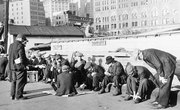If you're of a "certain age," you might remember that, just as war was raging overseas, there was turbulence stateside in the form of sizable labor disputes and rising unemployment, according to Albert E. Schwenk of the Bureau of Labor Statistics, a division of the U.S. Department of Labor. The decade was also marked by a shift from goods-producing jobs to service-oriented jobs, according to John Tschetter's 1984 report, "An evaluation of BLS' projections of 1980 industry employment," which appeared in the Monthly Labor Review, a BLS publication.
Basics
Generally speaking, if you earned around $7,500 in 1973, your pay was right in line with the national average, according to wage data from the Social Security Administration. By the close of the decade, you were earning the average if your salary was closer to $11,500. The average worker salary in 1979 is still about a fourth of what the average earner made in May 2009, according to BLS data. Of course, consumer goods and the cost of living have changed significantly from the 1970s to the 2000s; during the decade, a quart of milk set you back 33 cents, while a loaf of bread was less than a quarter, according to Texas-based Lone Star College-Kingwood.
Phenomena
There were at least two major trends that colored the general working landscape during the decade: increasing unemployment and major labor disputes, according to Schwenk's "Compensation in the 1970s." If you were a trucker, miner, postal worker or longshoreman during this time period, chances are you were either directly or indirectly involved with these strikes, as these sectors were responsible for some of the most sizable labor disputes of the time. In 1970, more than 210,000 employees of the U.S. Postal Service went on strike, and nearly 220,000 truckers went on a 10-day strike in 1979, according to Schwenk.
Emerging Jobs
A technological revolution was occurring during this decade, according to Lone Star College's American Cultural History portal. With new technology, including the introduction of the floppy disc, the microprocessor, VCR, laser printer, email and Atari, there were more opportunities in the working world for completely new types of professions. Some of the fastest-growing new or existing sectors, according to Tschetter's report, included those to support the space program for technology for guided missiles and space vehicles, as well as the aviation industry with the growth of air travel. Employment in these sectors grew nearly 10 percent and 10.5 percent, respectively, from 1972 to 1980.
Declining Jobs
If you were in industries such as textiles and livestock, you weren't so lucky, as these sectors suffered nearly 4 percent and 5 percent employment drops, respectively, from 1972 to 1980, according to Tschetter's analysis of BLS data. Tschetter notes that, generally, there was a shift from sectors that produced goods -- such as agriculture, construction and mining -- to those sectors that supported service jobs, such as transportation, information technology and finance. The American Historical Association also noted that humanities and social sciences fields suffered during the 1970s, while jobs in business and engineering got a boost.
Related Articles
References
- "An Evaluation of BLS' Projections of 1980 Industry Employment"; Monthly Labor Review; John Tschetter; August 1984
- Occupational Employment Statistics: Bureau of Labor Statistics
- Average Wage Index: Social Security Online
- "History in Those Hard Times: Looking for Jobs in The 1970s"; American Historical Association; Robert B. Townsend; Sept. 4, 2009
Writer Bio
Since 2000 reporting and writing has taken Michelle Leach to Michigan, Nebraska, Washington, D.C., Chicago, London and Sydney, Australia. Her stories have appeared in various media outlets including NBC's "The Today Show," Reuters, Chicagoland dailies and network affiliates across the United States. Leach has a master's degree from Northwestern University's Medill School of Journalism and a bachelor's degree in journalism/politics from Lake Forest College.











